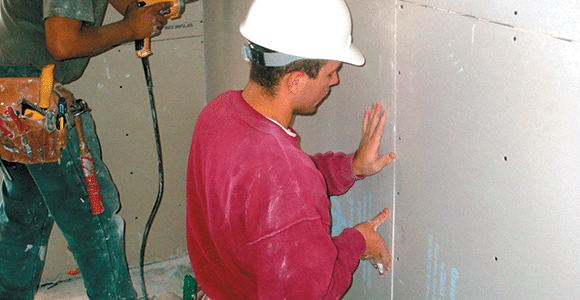Dear Jim: Our house walls need more insulation for efficiency and perhaps better soundproofing. We are also planning to add a bedroom. Will insulation make the existing rooms quieter and the new room more soundproof? — Bob J.
Dear Bob: Adding wall insulation can be an expensive project and above the skill level of most do-it-yourselfers. In many older houses, particularly ones with masonry walls, there is little space inside the walls for additional insulation. In many cases, it’s worthwhile to spend more on insulation with the highest R-value per inch, which is a number showing the ability of insulation to resist the transfer of heat. Higher R-values indicate more effective insulation.
Any type of insulation you add to save energy will help somewhat to soundproof the walls, but you need additional improvements for significant noise dampening because sound travels mostly through the wall studs.
For your new room addition, carefully installing fiberglass batt insulation boosts your home’s energy efficiency. The key word is “carefully” because fiberglass batts don’t provide protection from gaps at the wall joists — it’s up to you to make sure spaces are caulked or spray-foamed before insulating. Every crack and gap reduces the overall efficiency of the new wall. It’s difficult to eliminate all the air gaps in your existing walls, but having foam insulation injected is effective because it fills in spaces to eliminate air leakage.
If your windows are old, installing new ones makes the greatest improvement in saving energy and blocking outdoor noise. The airtight quality helps, but most new windows also use heavy inert gases in the gap between the panes that further reduce sound transmission.
In fact, simply caulking and weather stripping your old windows can have a dramatic effect on reducing noise, and it improves the energy efficiency of your house by keeping heated or cooled air from leaking out and outside air from seeping in. In turn, your heating and cooling system won’t need to work as hard and use as much energy.
When planning your new bedroom, do some research regarding the STC (sound transmission class) rating for various types of wall construction. A typical uninsulated interior wall with drywall on each side of 2-by-4 framing has an STC of about 34.
If there are common heating ducts and holes for electrical outlets and phone jacks, the STC of that interior wall may be only 25. Keep in mind that these openings are also culprits for drafty rooms, so using an inexpensive outlet insulation kit is one more way to improve energy efficiency. Adding insulation inside the wall increases the STC by very little — normal conversation would still be easily heard. At the other extreme, with an STC of 66, yelling is barely audible in adjacent rooms.
As with outdoor walls, your first step in soundproofing interior walls is to get out the caulk gun and seal any gaps in the walls and at joints. It won’t help energy efficiency much, but it does block the vibrations that create sound.
Decoupling the two surfaces of a wall is critical to block sound transmission. That means drywall on one side is not attached to the same wall studs as the drywall on the adjacent wall. One method is to stagger the studs on wider headers and footers in the wall cavity. The drywall on each wall is attached to every other stud so there is no direct path for the sound to travel.
The following companies offer wall soundproofing products: Acoustic Sciences, 800-272-8823, www.asc-soundproof.com; Certainteed, 800-782-8777, www.certainteed.com; Homasote, 800-257-9491, www.homasote.com; Owens Corning, 800-438-7465, www.owenscorning.com; and Serious Energy, 800-797-8159, www.quietrock.com.
Have a question for Jim?
Send inquiries to James Dulley, The Tennessee Magazine, 6906 Royalgreen Drive, Cincinnati, OH 45244, or visit www.dulley.com.



